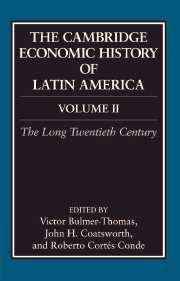Book contents
- Frontmatter
- Introduction
- Part I Cycles of Globalization
- Part II Onset of Modernization
- 5 The Institutional Framework
- 6 Fiscal and Monetary Regimes
- 7 Export-Led Industrialization
- 8 The Development of Infrastructure
- Part III Factor Endowments
- Part IV Sectoral Development and Equity
- Bibliographical Essays
- Index
- References
8 - The Development of Infrastructure
from Part II - Onset of Modernization
Published online by Cambridge University Press: 28 March 2008
- Frontmatter
- Introduction
- Part I Cycles of Globalization
- Part II Onset of Modernization
- 5 The Institutional Framework
- 6 Fiscal and Monetary Regimes
- 7 Export-Led Industrialization
- 8 The Development of Infrastructure
- Part III Factor Endowments
- Part IV Sectoral Development and Equity
- Bibliographical Essays
- Index
- References
Summary
Between 1870 and 1930, Latin American nations experienced an unprecedented expansion of physical infrastructure. The economies of Latin America, most of them laggards by the standards of North Atlantic economic performance, began to grow with a new-found rapidity, as investment in modern transportation increased during the late nineteenth century. For many nations of the region, this era became one of genuine economic transformation. Increasing exports of primary commodities, rising imports of capital goods, the expansion of activities drawing directly and indirectly on overseas investment, the rising share of modern manufacturing in output, and a generalized increase in the pace and scope of economic activity were all tied closely to the timing and character of the region’s infrastructural development. The causation in this process ran both ways. Infrastructure development fostered economic growth, as marketing and transaction costs fell. Economic growth led to new sequences of infrastructure investment, as the demand for improvements increased, the costs of provision fell, and new bottlenecks emerged, creating commercial and political pressures for follow-on investment. In 1850, no major country in Latin America possessed any of the trappings of modern transport technology. Half a century later, most of them did, and had experienced considerable economic change as a result.
- Type
- Chapter
- Information
- The Cambridge Economic History of Latin America , pp. 293 - 326Publisher: Cambridge University PressPrint publication year: 2006
References
- 16
- Cited by



